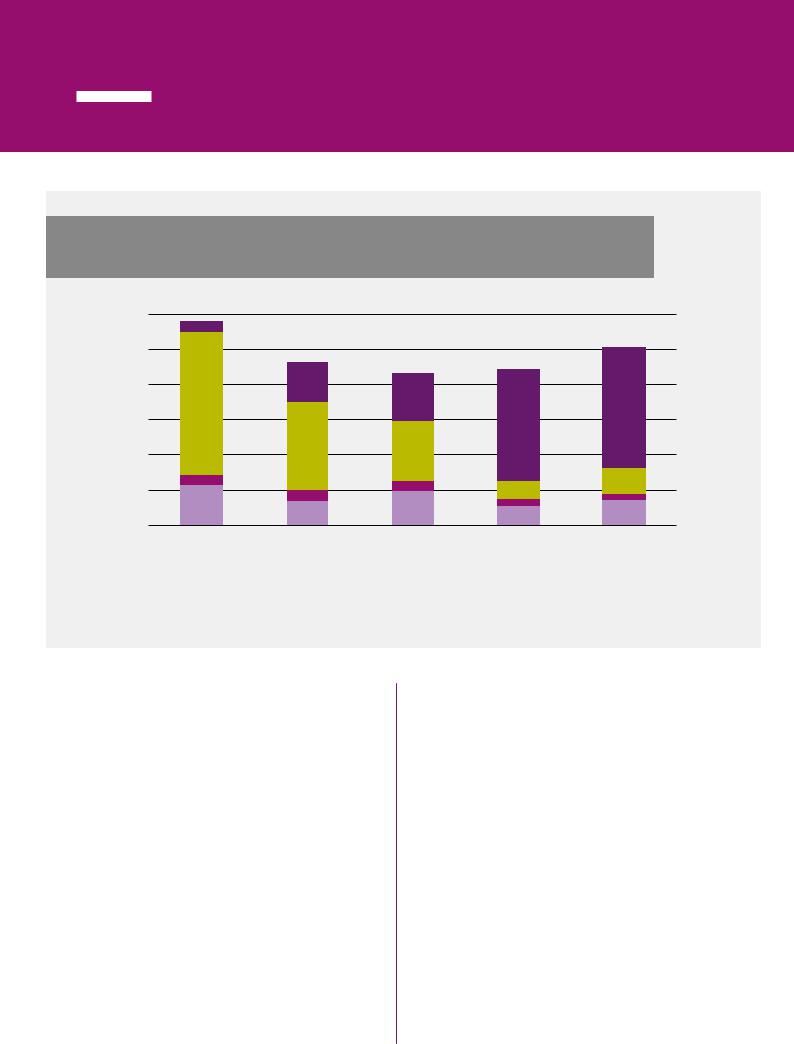
Agricultural commodity markets
.pdf
vk.com/id446425943
PART 4 ADAPTING TO CLIMATE CHANGE AND MITIGATING ITS IMPACT: DOMESTIC POLICIES AND SUPPORT MEASURES
Key points
1 Many government measures can promote adaptation, mitigation and food security
and have no or minimal distortionary impact on trade. These include research and development, extension, training, technical assistance and investments that can all promote the adoption of climate-smart agriculture practices.
2 Appropriate incentives may nevertheless be necessary to further facilitate
adaptation and mitigation in agriculture. For example, some types of subsidies can promote large-scale adoption of climate-smart agriculture practices. While discussions may have to focus on their potential impact on production and trade, consideration should also be given to their effectiveness in adaptation and mitigation.
3 Agricultural insurance will be increasingly necessary to protect against climate risk,
but its cost is likely to rise. While the use of insurance subsidies may, in certain cases, be trade distorting, the need to hedge against climate risk should be considered.
4 Emergency humanitarian food reserves at the regional level can promote
adaptation to climate change and contribute to food security. These can enhance efficiency and reduce costs by pooling resources across countries.

vk.com/id446425943
PART 4
ADAPTING TO CLIMATE CHANGE AND MITIGATING ITS IMPACT: DOMESTIC POLICIES AND SUPPORT MEASURES
Agricultural policies address a broad array of objectives. They promote efficiency and correct market failures, such as constraints faced by farmers in adopting new technologies due to lack of information. They support equity, helping to achieve and maintain a level of farm income that keeps pace with income in other economic sectors and is in line with society’s aspirations. They strive to ensure the provision of public goods to society at large. And in many developing countries, they promote food security through measures aimed at both producers and consumers.
Countries provide various types of support to farmers, ranging from direct payments that contribute towards maintaining farm incomes without affecting output; to subsidies for inputs such as electricity, water and fertilizer that can increase production. All these measures shape agriculture’s adaptation and mitigation to climate change. Domestic support measures are also subject to the rules and disciplines of WTO agreements, particularly the AoA, which aims to reduce trade distortions and establish a fairer agricultural trading system that will increase market access and improve the livelihoods of farmers around the world. n
POLICIES TARGETING ADAPTATION AND MITIGATION IN PRODUCTION UNDER THE AGREEMENT ON AGRICULTURE
Climate change will likely affect the relative prices of agricultural products and those of inputs (see Part 2). These changes may prompt farmers to change the crops they grow and the types of livestock they raise in order to increase returns and reduce risk. Farmers may also alter their management practices, and some of the actions they take to enhance productivity could reduce emissions.
Policies will be necessary to facilitate such autonomous adaptation and mitigation efforts. Provided farmers have the necessary information and access to markets and technology and do not face institutional barriers to adoption, such as lack of finance, they are likely to take advantage of new technologies and practices that are both cost reducing and climate friendly.
More than 30 countries, mostly in sub-Saharan Africa, specifically refer to climate-smart agriculture (CSA) in the INDCs they submitted to the UNFCCC. Climate-smart agriculture is an approach that helps to guide actions to transform and reorient agriculture and food systems (including fisheries and aquaculture) to support development and to ensure food security in a changing climate. CSA has three main objectives: sustainably increasing agricultural productivity and incomes; adapting
| 44 |

vk.com/id446425943
THE STATE OF AGRICULTURAL COMMODITY MARKETS 2018
and building resilience to climate change; and reducing and/or removing GHG emissions, where possible.68
A wide range of policies and regulations creates a set of incentives and disincentives for achieving progress across the three objectives, but making the transition to climate-smart agriculture requires balancing trade-offs across economic, social and environmental goals. Central to CSA is the development and adoption of innovative technologies and practices that promote productivity growth, adaptation and mitigation. Other measures include improvements in agricultural risk management and safety nets such as emergency food reserves and social protection, but also measures and regulations that promote mitigation in agriculture through reduced emissions or increased carbon sequestration.
Clearly, CSA requires policy coherence across sector-specific and economy-wide interventions. It also involves higher costs related to funding climate-smart investments and providing the capacity and necessary incentives to producers to adjust to a changing climate, especially small-scale family farmers in developing countries where food security and rural development are priorities.
Trade-distorting policies: Market price support and input subsidies
Price support or payments linked to production fall in the Amber Box and are subject to limits, with specific exemptions for developing countries (see discussion in Part 3). Within these limits, countries might use such policies to influence the production of commodities that are important for food security or to diversify production to reduce the potential vulnerability of food supplies under climate change.
For example, the Price Loss Coverage (PLC) programme or the Agricultural Risk Coverage (ARC) programme in the United States of America, introduced with the 2014 Farm Bill, are reported as Amber support. Under PLC, participating grain and oilseeds producers receive a payment when national season-average farm prices fall below fixed reference prices. Under ARC, payments occur when county or farm-level revenues per acre fall below 86 percent of a benchmark.69 In India, price policies aim to support farmers, promote rural development, and at the same time address food insecurity. The Food Corporation of India provides market support by setting minimum prices that ensure returns for farmers, while subsidizing food distribution to help poor consumers, in line with the 2013 National Food Security Act.70
Market price support, often used in conjunction with trade policies, has been shown to increase production, thus contributing to domestic food availability. But such support can also result in food surpluses, which in the case of large producing countries can significantly distort trade. Within the context of climate change, unless measures are taken to improve agriculture’s emissions efficiency (that is to reduce emissions per unit of output), the increase in production due to market price support would also result in an increase in total emissions. A reduction in this production-coupled domestic support could reduce output and emissions in a manner similar to the imposition of a carbon tax.71
Like market price support, input subsidies can also lead to higher production. Input subsidies are subject to Amber Box provisions, but not if used by developing countries to benefit low-income or resource-poor producers (see Table 4.1). Indeed, in developing countries input subsidies can promote food security by redressing, at least temporarily,
| 45 |

vk.com/id446425943
PART 4 ADAPTING TO CLIMATE CHANGE AND MITIGATING ITS IMPACT: DOMESTIC POLICIES
market failures such as missing markets for credit and inputs, and a lack of knowledge of the benefits of using technologies, such as drought-resistant seeds and fertilizers.
For example, in Africa, where fertilizer consumption averages about 22 kilograms of nutrients per hectare – that is only 15 percent of the world’s average – many countries have implemented large-scale, multi-year fertilizer subsidies.72 The Agricultural Input Subsidy Programme in Malawi and the Fertilizer Support Programme in Zambia are examples of this. These programmes aim to address cash constraints faced by farmers and strengthen the demand for inputs to increase production and enhance food security. They target small-scale family farms through vouchers and grants and attempt to promote private sector solutions for the provision and distribution of inputs, with the goal of consolidating input marketing systems, which currently suffer from a lack of economies of scale.73
Available evidence suggests that subsidies have been effective in raising fertilizer use, average yields and agricultural production. But their success depends strongly on implementation performance, and cannot be entirely separated from exogenous factors such as favourable weather.74 Climate change may compromise the effectiveness of these programmes, but there is also a trade-off between food security objectives and adaptation and mitigation targets. Subsidies can encourage production, but also the inefficient use of fertilizer: if inputs are underpriced they will tend to be overused, which over the long term can result in maladaptation to climate change. However, with fertilizer having a high marginal productivity in parts of Africa (small amounts of fertilizer can result in proportionally larger amounts of output), such subsidies could result in both increased production and emissions efficiency. In order to increase production and reduce emissions per unit of output, subsidy programmes should encourage the efficient uptake of inputs as part of an integrated package of sustainable production practices. For example in the case of fertilizer subsidies, programmes must promote the judicious use of fertilizers and enhance farmers’ knowledge on soil properties and site-specific nutrient management.75
Domestic support with minimal trade-distorting effects
Domestic support measures that are covered by the Green Box (Annex 2 of the AoA) include programmes that are decoupled from production. These measures include expenditure on research and development (R&D) and extension, payments under structural and regional investment programmes, support for food reserves and agricultural risk management. These measures have no (or at most minimal) distorting effects on trade (see Table 4.1).
Research and development, and extension programmes
R&D, training and extension, and advisory services are highly relevant for pursuing climate change adaptation and mitigation objectives (Table 4.1, paragraph 2). Improvements in technology and their adoption by farmers are crucial. Productivity in agriculture has benefited enormously from changes in technology brought about by R&D. From the early 1950s to the late 1970s, the Green Revolution in Asia – driven by technology improvements targeting small farms – more than doubled food production, although at the same time it caused environmental damage.
Technology adoption and improvements in crop and livestock management have resulted in major increases in Total Factor Productivity (TFP) in many regions.76 It is estimated that the growth in TFP accounted for roughly two-thirds of the increase in global agricultural output during the period 2001–14, with growth in inputs such as land, labour, fertilizer, energy and irrigation accounting for the remainder (see Figure 4.1).
Technology and farm management improvements should not only promote productivity but also foster adaptation and reduce emissions per unit of output, as for example CSA practices do.
Technological change, extension and training will play a vital role in promoting CSA approaches and ensuring sustainability in agriculture in the face of climate change. Climate-smart technologies adopted today will make a huge difference in the future. For example, in Mali and Malawi, half of the population engaged in
| 46 |

vk.com/id446425943
THE STATE OF AGRICULTURAL COMMODITY MARKETS 2018
TABLE 4.1
ANNEX 2 OF THE AGREEMENT ON AGRICULTURE: GREEN BOX SUPPORT MEASURES.
Paragraph
2
Description
Provision of general services that provide benefits to agriculture or the rural community, such as research and extension, pest and disease control, inspection services, marketing and promotion services and infrastructural services, including those associated with environmental programmes.
Key provisions
Must not involve direct payments to producers or processors. Support for infrastructural services limited to capital costs, not operating costs.
3 |
Public stockholding programmes for food security |
May include aid for private storage. Purchases and |
|
purposes. |
sales must be at current market prices. |
||
|
|||
|
|
|
|
|
|
Can be direct provision of food or at subsidized |
|
4 |
Domestic food aid programmes. |
prices. Government purchases must be at current |
|
|
|
market prices. |
|
|
|
|
|
|
|
Payments must not relate to production, prices or |
|
5&6 |
Decoupled income support to producers. |
factors of production. No production required to |
|
|
|
receive payment. |
|
|
|
|
|
7 |
Government financial participation in income |
Compensation for maximum of 70 percent of income |
|
loss and triggered by an income loss that exceeds |
|||
insurance and income safety-net programmes. |
|||
|
30 percent compared to a reference period. |
||
|
|
||
|
|
|
|
|
|
Triggered by a production loss greater than |
|
|
Payments (made either directly or by way of |
30 percent with respect to an average in prior years |
|
8 |
government financial participation in crop insurance |
and limited to replacement cost. Combined payments |
|
|
schemes) for relief from natural disasters. |
under paragraphs 7 and 8 not to exceed |
|
|
|
100 percent of total loss. |
|
|
|
|
|
9 |
Structural adjustment assistance provided through |
Conditional on total and permanent retirement. |
|
producer retirement programmes. |
|||
|
|
||
|
|
|
|
10 |
Structural adjustment assistance provided through |
Requires land retirement for minimum of three years |
|
resource retirement programmes. |
or permanent disposal of livestock. |
||
|
|||
|
|
|
|
11 |
Structural adjustment assistance provided through |
No linkage of aid to specific products or to their |
|
investment aid. |
prices is allowed. |
||
|
|||
|
|
|
|
|
|
Payment limited to the extra costs or loss of income |
|
12 |
Payments under environmental programmes. |
involved in complying with conditions on production |
|
|
|
methods or inputs. |
|
|
|
|
|
|
|
Payments limited to extra costs or loss of income |
|
13 |
Payments to producers in disadvantaged regions |
involved in agricultural production in a prescribed |
|
under regional investment programmes. |
area. These cannot be based on production or prices |
||
|
in any year after a base period.
agriculture are women who, as a result of gender inequality, have significantly less access to land, information, finance and agricultural inputs. The challenges they face will only worsen in light of climate change; CSA programmes in these countries are working to leverage information and communication technologies (ICTs) to provide them with access to agricultural inputs.77
In Zambia, investments have been made in extension and training aimed at promoting conservation agriculture (CA) – a climate-smart
practice based on minimum soil disturbance, crop rotation and soil organic cover.78 CA holds tremendous potential for all sizes of farms and agro-ecological systems. It can facilitate adaptation through increased water infiltration that allows soils to absorb most of the rainwater even during extreme rainfall events, and improve water-holding capacity which increases the ability of plants to survive during drought periods. At the same time, CA can reduce emissions from fossil fuels compared to conventional agriculture by up to 60 percent, and
| 47 |

vk.com/id446425943
PART 4 ADAPTING TO CLIMATE CHANGE AND MITIGATING ITS IMPACT: DOMESTIC POLICIES
FIGURE 4.1
SOURCES OF GROWTH IN GLOBAL AGRICULTURAL OUTPUT
AVERAGE ANNUAL GROWTH RATE OVER PERIOD
3.0%
2.5%
2.0%
1.5%
1.0%
0.5%
0.0%
1961–70 |
1971–80 |
1981–90 |
1991–00 |
2001–14 |
|
New land |
|
Irrigation |
|
Input/Area |
|
Total Factor Productivity |
|
|
|
|
SOURCE: USDA, Economic Research Service, International Agricultural Productivity data products, as of October 2017. Inputs include fertilizer, machinery, labour, and other inputs per acre of cropland.
limit the use of fertilizer and agrochemicals in the long term by 20 percent. However, CA’s largest contribution in mitigating climate change can be obtained from carbon sequestration – under humid temperate conditions,
0.1–0.5 tonnes of organic carbon can be captured on average per hectare of land.79
Investments in training and extension in Zambia have benefited approximately 16 percent
of small-scale family farmers in the country, enhancing not only production levels and food security, but also soil organic matter content. This brought about increases in soil nitrogen, and improvements in water-holding capacity and infiltration.80
In Canada, the dairy Agricultural Greenhouse Gas Program aims to reduce methane emissions from cows through: diet optimization; the use of lipids in cattle diets to decrease enteric emissions; and harvesting forages at optimum maturity to maximize their digestible energy. The
research programme also focuses on the use of improved technology for manure management (storage and treatment of animal waste) to reduce emissions of nitrous oxide.81
Evidence on the impact of climate-smart agriculture approaches on adaptation and mitigation is being built up. In Zambia, where efforts to apply conservation agriculture have been significant, studies suggest that its adoption improves the level of sustainable crop productivity and income, and that individual CA components (minimum tillage, permanent soil cover and diversified rotation) have specific effects on improving soil fertility.82
More generally, agricultural R&D has a very high social value. Annual internal rates of return on investments in agricultural R&D range between 20 and 80 percent.83 In developing countries, the dollar-for-dollar impact of such investments on the value of agricultural production is generally within the range of 6 to 12 percent across
| 48 |

vk.com/id446425943
THE STATE OF AGRICULTURAL COMMODITY MARKETS 2018
countries.84 Countries that have heavily invested in agricultural research while simultaneously investing in extension services have had the strongest productivity growth.85 A climate-smart stimulus on R&D and extension services could have an enormous benefit on productivity and climate change adaptation and mitigation.
Support for risk management
Climate change is likely to increase the frequency and severity of extreme weather events. It is almost certain that the frequency and magnitude of warm daily temperature extremes will increase by the end of the century. It is very likely that the length, frequency and/or intensity of heatwaves will also increase, as will the frequency of heavy precipitation events. There is medium confidence that droughts will intensify in some seasons and areas. It is difficult to predict the impact of extreme weather events on major crops, however most analyses suggest that the variability for key food staples such as rice, maize and wheat will increase as the century progresses.86 These increased risks will negatively affect the economic returns of agriculture, farmers’ livelihoods, and the capacity of the sector to invest and innovate. Strengthening the capacity to manage risks will be important.
Farmers manage variations in production and prices as part of their regular business. In developed countries where agriculture is adequately integrated with financial markets, price risk can be managed through the use of futures markets and related financial instruments. Forward contracting may also be possible, through which a producer locks in a selling price with a future purchaser at the time production decisions are made. In developing countries for instance, the Purchase for Progress programme of the United Nations World Food Programme (WFP) uses forward contracts to purchase food produced by small-scale family farmers through farmers’ organizations. Farm households also manage risks by diversifying production or their income sources, for example through off-farm employment.
These private risk-management strategies can be used to manage short-term price risk, but they are unlikely to be suitable for managing
production risks due to extreme weather events. For this, agricultural insurance is often used or disaster assistance may be provided by the government – Annex 2 of the AoA involves several programmes oriented towards promoting such risk management instruments (see Table 4.1, paragraphs 7 and 8).
Agricultural insurance is generally characterized by indemnity-based programmes that cover losses against named perils (such as hail) or multiple perils (such as drought or excessive moisture, hail, wind, frost, insects and disease). Indemnity-based insurance involves high costs associated with administering contracts and determining losses with large numbers of dispersed farmers. It is also prone to moral hazard and adverse selection problems, which add to these costs.87
Because costs are generally high relative to other risk-management strategies, such as income diversification, the demand for agricultural insurance products, in the absence of subsidies, tends to be low. This makes insurance markets commercially unviable, and insurance programmes in developed countries are generally highly subsidized. According to a survey of agricultural insurance programmes in 65 developed and developing countries, almost two-thirds of the countries subsidized premium costs with an average subsidy rate of 47 percent.88 For example, the public costs of the programme in the United States of America are projected to exceed USD 8 billion annually over the period 2017–27, an expenditure of almost 90 cents for every USD 1 premium written.89
The high cost of conventional, indemnity-based insurance makes it difficult for developing countries to provide subsidized coverage for numerous and geographically-dispersed
small-scale family farmers. Innovations such as weather-index-based insurance seek to address this challenge. With index-based programmes, farmers are paid whenever rainfall or temperature is lower or higher than specific thresholds that are likely to cause a significant fall in crop yields. Events such as droughts, frost, or precipitation can also have specific thresholds assigned; measurements are then taken by weather stations or even satellite technology.
| 49 |

vk.com/id446425943
PART 4 ADAPTING TO CLIMATE CHANGE AND MITIGATING ITS IMPACT: DOMESTIC POLICIES
Index-based insurance can be provided at lower costs – insurers do not need to make field-level assessments and therefore operational costs (and thus insurance premiums) are reduced.
In India, the Weather-based Crop Insurance Scheme (WBCIS) provides insurance to over
13 million farmers for various climatic risks such as deficit rainfall, dry spells, excess rainfall, low temperature, high temperature, high humidity, and high wind. The Agriculture and Climate Risk Enterprise (ACRE) in sub-Saharan Africa is now the largest index insurance programme in the developing world in which the farmers pay a market premium, and the first agricultural insurance programme worldwide to reach smallholders using mobile technologies. Subsidies do, however, continue to play a crucial role.90 For WBCIS, premium subsidies vary by insurance programme and by state, but in general the government provides between 60 and 75 percent of the premium.
Agricultural insurance has witnessed a dramatic growth, largely as a result of substantial government subsidies. In the United States of America, for example, average coverage levels for most row crops have grown significantly and continuously since the late 1990s, when subsidies were increased for higher coverage levels.91 However, agricultural insurance is not entirely neutral when it comes to production distortions. Crop insurance subsidies have had minor impacts on production in areas where insurance is broadly available across crops. Impacts are likely to be larger on crop choice when insured crops compete for land against uninsured crops, or when crops where revenue insurance is available compete against crops where only yield insurance is available.92
At the same time, the link between production and insurance, although weak, has raised concerns that subsidies not only help reduce risks but may also distort production and trade, especially in developed countries. Government support for crop and income insurance, as well as disaster assistance, is exempt from reduction commitments under the AoA. To be exempt, such programmes must meet certain criteria relating to production loss thresholds, payment limits in respect of losses of income, livestock, land or
other production factors, as well as to the calculation of such payments. Both paragraphs 7 and 8 (see Table 4.1) establish limits on compensation payments.
These criteria make it difficult to report insurance programmes in the Green Box. Most area-based yield programmes or weather index-based derivative products tend to offer coverage for losses higher than 70 percent of income or yield. These coverage levels are often based on expected yield or income outcomes, which may differ from averages of past outcomes. Another important point is that the 70 percent coverage limit under paragraph 7 of Annex 2 may be overly stringent for index-based insurance: the effects of perils on individual yield or revenue vary widely across farmers, but index variability is typically substantially lower.
Agricultural insurance forms an important component of CSA. However, because of discrepancies between programmes that are actually in place and the conditions needed to meet Annex 2 criteria, most countries that notify insurance programmes to the WTO do so as Amber Box support. It is likely that increased yield variability due to climate change will increase the costs of insurance and premiums. This may reduce the attractiveness of agricultural insurance as an adaptation option, unless governments continue to subsidize a large share of the premium costs. Insurance companies may also be less willing to underwrite risks without large public support in the form of reinsurance. Consequently, the amount of support that should be notified as Amber Box under the AoA is likely to increase with climate change, unless changes are made in the conditions that govern this.
Stabilizing domestic markets – support for stockholding
While agricultural insurance is important, the need for risk management extends beyond the farm to the broader population, since both availability and access to food can be affected by shocks induced by climate change. In many developing countries spending on food is a major share of total consumer expenditure, and short-term price spikes due to climate-induced reductions in production can have serious
| 50 |

vk.com/id446425943
THE STATE OF AGRICULTURAL COMMODITY MARKETS 2018
implications for food security, especially for the poor and the vulnerable.
In this context, food stocks can contribute to climate change adaptation. Holding food stocks such as grain costs money both through the expense involved in maintaining and operating storage facilities and the opportunity cost of delaying the sale of the commodity. Private stockholders will hold inventories in line with their expectations on the price, purchasing food when prices are low and releasing stocks onto the market when prices are high. In this manner, stocks, much like trade, tend to buffer the impacts of fluctuations in supply.
Public stockholding programmes have a long history. In many cases, their primary objective is to ensure food security and address emergency food shortages. In other cases, buffer stocks – large public stockholding programmes that operate through domestic procurement to stabilize prices within a predetermined band and in combination with trade measures – are used to support producer prices.
Such large-scale public stockholding programmes have been criticized for a number of reasons. First, they tend to be costly, in terms of both procurement and storage. The longer food commodities are held in storage, the costlier it becomes given the risk of deterioration and the need to rotate existing stocks. Second, procurement prices are often set at higher levels relative to market prices, leading to large stock acquisitions and distorting production decisions. Third, buffer stocks can distort international markets if governments decide to dispose of stocks through exports.
In fact, public spending on the operating losses of large-scale stockholding programmes in many countries has been higher than investment in agricultural R&D. In India for example, public spending on stockholding programmes in 2008–09 amounted to
1.5 percent of GDP, compared with 0.06 percent dedicated to agricultural R&D. In Zambia the cost of maintaining public stocks was estimated at 1.9 percent of GDP in 2011, while spending
on agriculture as a whole in 2010 accounted for 0.6 percent of GDP.93
Unlike large-scale buffer stock schemes, relatively small public food reserves designed exclusively for meeting emergency food needs minimize distortionary impacts while helping to mitigate the impact of production shortfalls, particularly in countries where transportation costs may delay imports in times of supply shortages. In addition, such food emergency reserves are less likely to disrupt private sector storage activity, and if linked to social protection mechanisms can effectively target the poor and the vulnerable.
The costs of emergency reserves can be reduced through regional collaboration in stockholding policy and by combining physical stocks with financial resources that allow countries to purchase additional supplies in times of need.94 Rather than requiring each country to hold sufficient food stocks to meet a shortfall in its domestic production, regional emergency food stockholding schemes, such as the ASEAN Plus Three Emergency Rice Reserve (APTERR) and the Economic Community of West African States (ECOWAS) Regional Food Security Reserve, can allow countries to pool risks (see Box 4.1).
Provided they also meet policy-specific criteria laid out in paragraph 3 of Annex 2 of the AoA, expenditures associated with the acquisition and holding of stocks for food security purposes can qualify under the Green Box (see Table 4.1). Buffer stocks and price stabilization mechanisms in which procurement is based on pre-announced statutory prices that exceed base-period reference prices could be considered as trade-distorting support. In such a case, expenditures that cover their operating losses could be considered as subsidies to be reported under the Amber Box.95
The provisions in paragraph 3 of Annex 2 have been controversial in the WTO, with a number of members seeking to relax the criteria to allow developing countries’ public stockholding programmes that incorporate price support to qualify for the Green Box. The proposed changes have been strongly opposed by a number of exporting countries on the basis that if administered prices are set too high they will »
| 51 |

vk.com/id446425943
PART 4 ADAPTING TO CLIMATE CHANGE AND MITIGATING ITS IMPACT: DOMESTIC POLICIES
BOX 4.1
REGIONAL FOOD RESERVES
ECOWAS Regional Food Security Reserve
The ECOWAS Regional Food Security Reserve was established following a decision at the Economic Community of West African States (ECOWAS) Heads of State Conference in February 2013. The reserve has a physical component composed primarily of cereals (millet, sorghum, maize and rice) and tubers (cassava). There is also a financial component, equal to approximately two-thirds of total resources. The reserve is intended to be the third line of defence in preventing and managing food crises, complementing local stocks in villages and communities and national food security stocks in member states. It has a planned intervention capability of 410 000 tonnes and its financing plan is based on a combination of national, regional and international resources, while initial funding for the acquisition of stocks was provided by the European Union (Member Organization). A special unit within the Regional Agency for Agriculture and Food (RAAF), which is headquartered in Lomé, Togo, is responsible for the technical management of the reserves with the involvement of the Network of National Food Security Storage Companies and Agencies (RESOGEST). The Regional Food Security Reserve strengthens the forward position of assistance relying on existing storage infrastructure in four subspaces: (i) Northern Benin, Niger, Nigeria (East Subspace); (ii) Southern Burkina Faso, Northern Côte d’Ivoire, Northern Ghana, Southern Mali, Northern Togo (Central Subspace);
(iii)Cabo Verde, the Gambia, Guinea-Bissau, Senegal (West Atlantic Subspace); and,
(iv)Guinea, Liberia, Sierra Leone (Atlantic Gulf Subspace).
The ASEAN Plus Three Emergency Rice Reserve (APTERR)
The ten member countries of the Association of Southeast Asian Nations (ASEAN), in partnership with the People’s Republic of China, Japan and the Republic of Korea, agreed on the creation of APTERR in October 2011. APTERR became operational in July 2012 and is composed of earmarked pledges and physical pledges (rice exclusively allocated to the reserve). The total volume of rice earmarked under the scheme is 787 000 tonnes. The agreement does not require distinct physical stocks of rice, as long as a member makes its earmarked stock available to other members, as a permanent commitment. APTERR is governed by a council composed of 13 members, one from each of the signatories to the agreement. Day-to-day management is performed by a secretariat based in Thailand, with operations supported by an initial endowment and annual financial contributions provided by APTERR Parties.
There are three programmes or "Tiers" under which APTERR stocks can be released. Under Tier 1, in case of an emergency, earmarked reserves can be released under the terms of a forward contract, which is valid for three years and can be renewed. Under Tier 2, stocks can be released to requesting countries on a voluntary basis through long-term loan agreements or
grants. Tier 3 covers the release of donated stocks and cash donations for the procurement of rice to meet acute (and likely localized) emergencies.
The regional reserve is not deployed to achieve a target price or even a price band, but only to meet food requirements of a member country in extremis. The agreement contains a commitment that the operations of the reserve will not distort normal international trade in rice.
Source: USAID and ECOWAS Commission. 2012. Methodological guide to the operations of the Regional Agency for Agriculture and Food; Briones, R.M. 2011. Regional Cooperation for Food Security: The Case of Emergency Rice Reserves in the ASEAN Plus Three. Sustainable Development Working Paper Series No. 18, Asian Development Bank.
| 52 |
